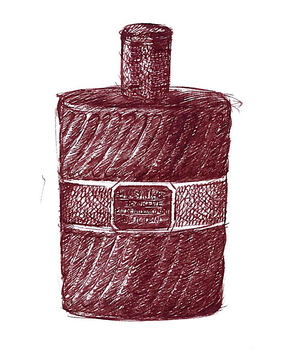Christian Dior
Eau Sauvage
 How did I get this far without reviewing Eau Sauvage? And now that I’ve finally got round to reviewing it, how am I going to do justice to such an iconic perfume? OK, I’ve covered Eau Sauvage Extrême, but that’s a dreary spin-off and bears little relation to the glorious real thing. So, deep breath now, and here we go.
How did I get this far without reviewing Eau Sauvage? And now that I’ve finally got round to reviewing it, how am I going to do justice to such an iconic perfume? OK, I’ve covered Eau Sauvage Extrême, but that’s a dreary spin-off and bears little relation to the glorious real thing. So, deep breath now, and here we go.
Created by the legendary perfumer Edmond Roudnitska, Eau Sauvage was launched in 1966, and it’s deservedly regarded as one of the greatest men’s perfumes of all. Roudnitska’s took the idea of a classic men’s cologne, packing it full of fresh, zingy, clean-smelling bergamot-orange oil from southern Italy, but then he did a brilliant thing, by blending it with an equally strong dose of a recently patented chemical called Hedione.
Hedione smells of jasmine – as well it might, since it was discovered by chemists during the process of deconstructing the molecular bits and bobs that, collectively, create natural jasmine’s heady, narcotic scent. Hedione’s real name is methyl dihydrojasmonate, and it was first isolated in 1958 by Dr Edouard Demole, who worked for the giant Swiss perfume company Firmenich.
Methyl dihydrojasmonate has a light jasmine smell but also something citrusy about it, giving Edmond Roudnitska a jigsaw piece that fitted into both the bergamot orange of a man’s cologne, and also had something – but crucially not too much – of natural jasmine’s sumptuous, powerfully floral scent, which most men would have considered far too feminine to wear.
To this Roudnitska added lavender – another floral scent, though this time one whose herby, faintly sweaty character had made it a long-standing male favourite – as well as a range of other, less pronounced ingredients including oakmoss (originally extracted from a lichen that smells of forests after rain) and patchouli, which in small amounts, I’m guessing, enhances the dandified character of Eau Sauvage without pushing it over into full-on let-it-all-hang-out hippiness.
A great perfume is one thing, and an all-too-rare thing at that, but it’s rarer still for a brilliant perfume to be supported by great marketing and presented in a great bottle. And here Eau Sauvage struck lucky again. Christian Dior died in 1957 of a heart attack, but under Yves Saint Laurent and then Marc Bohan, the company commissioned a series of sexy, tongue-in-cheek yet effortlessly elegant posters from René Gruau, arguably the greatest fashion illustrator of the 20th century. They certainly added to Eau Sauvage’s masculine appeal.
Few of us think a great deal about the bottles that contain the perfume we use, though they do have their collectors (most of whom, oddly, seem to have lost interest in the perfumes they contain). But some bottles repay a second glance, and Eau Sauvage is one of them. It was designed by Pierre Camin, who worked for Baccarat and created many of the bottles for the perfumer François Coty, and its chic silver cap, embossed with a pattern of tiny overlapping scales like a freshly-caught mackerel, is said to have been inspired by the silver thimble that Christian Dior always had to hand. The diagonally ridged sides of the bottle itself, meanwhile, are supposed to resemble the regular pleats of a Dior dress, though that seems a bit of a stretch to me.
I could go on, but in the unlikely event that you’ve never smelled Eau Sauvage, or think of it as a tired old dinosaur, I’d rather you headed out and tried it for yourself. Just be careful, though, as Dior have experimented with different versions over the years, and what’s now called Eau Sauvage Extrême (which you’d think would just be a stronger version, as indeed it used to be) is now a completely different fragrance, pleasant enough in a dull way but far less exciting than the original.
My last words, though, go to Edmond Roudnitska, not only because he was a perfumer of genius, but also because he also had something so important to say about marketing that it should be tattooed on the forehead of every perfume-company PR.
‘The choice of a perfume,’ he said, ‘can only rest on the competence acquired by education of olfactive taste, by intelligent curiosity and by a desire to understand the WHY and the HOW of perfume. Instead, the public [is] given inexactitudes and banalities. The proper role of publicity is to assist in the formation of connoisseurs, who are the only worthwhile propagandists for perfume, and it is up to the perfumers to enlighten, orient and direct the publicity agents.’
Here’s to the day his dream comes true.
2 Responses to “Eau Sauvage” Leave a Comment
Leave a comment
Vladimir on 24 December, 2013 8:41 am
I want to thank you for such wonderful reviews on perfume. And also for the wonderful concept site, bravo! I look forward to new reviews.
ferris on 31 August, 2014 10:40 am
so well put! great review. this is another Classic scent from Edmond Roudnitska that I adore. The other is Eau d’Hermes.